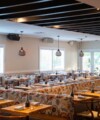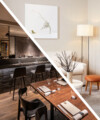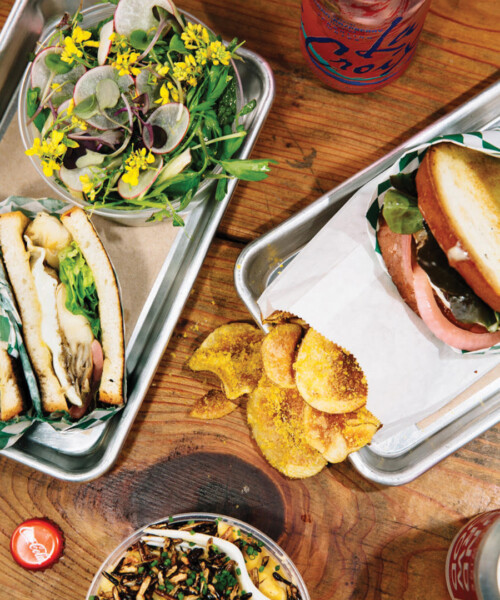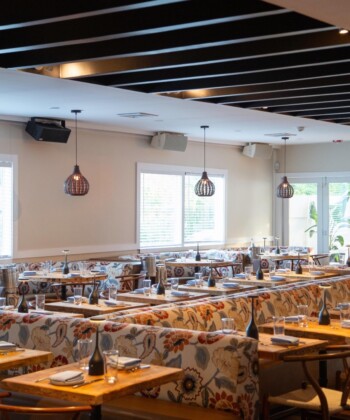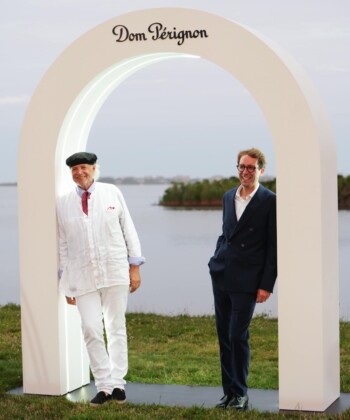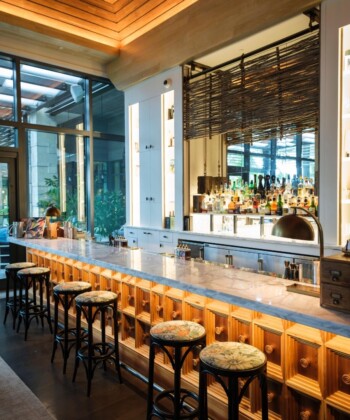Classic diners—the kind that dot the country from Maine to California and offer mile-long menus packed with grilled cheese sandwiches and silver-dollar pancakes—have long been a destination for those seeking the comfort of familiar (if not spectacular) American fare. In his book Catching the Big Fish: Meditation, Consciousness, and Creativity, filmmaker and artist David Lynch wrote, “There’s a safety in thinking in a diner. You can have your coffee or your milkshake, and you can go off into strange dark areas, and always come back to the safety of the diner. … They’re brightly lit, with chrome and booths and Naugahyde and great waitresses.” And while their numbers have dwindled in recent years, greasy spoons remain for many of us a comforting throwback beloved for their familiarity, though not necessarily for their culinary prowess. However, that might all be about to change.
A new generation of diners is popping up across the United States, doubling down on the charm and comfort of the classic concept but giving their menus a decidedly epicurean overhaul. “In the last couple of years, many old-school diners have been shutting their doors, and there was a sense of loss,” says Ann Redding, the chef and restaurateur of the new Thai Diner in New York City. “I think this recent resurgence in diners shows that these sort of neighborhood community gathering places are still needed.”

Desserts at Thai Diner
Kristopher Schram, the chef and owner of the West Taghkanic Diner in Ancram, New York, agrees. “There is something very comforting about diners,” he says. “When we take a seat at the counter or in the booth and the waitress starts pouring the coffee, I think a lot of us are craving that.”
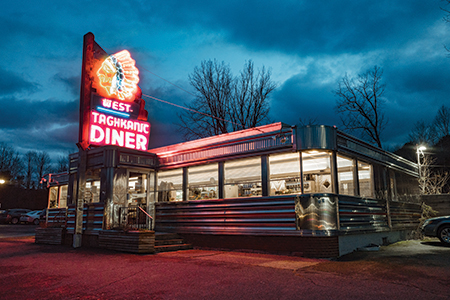
West Taghkanic Diner
Phoenicia Diner in upstate New York is housed in an original 1962 DeRaffele building that has been restored with its original charm intact. “We strive for authenticity and a level of respect for the original design,” says owner Mike Cioffi. “I like the combination of nostalgia mixed in with a healthy dose of comfort food as a response to fussy and formal eating.” Whittling down their menu from the traditional multipage one was also necessary. “I remember paging through the menus as a kid but always gravitating toward 10 or 12 things that I was familiar with,” says Cioffi. “In our case, we chose to highlight menu items that we could create from scratch, source locally and that were familiar, like corned beef, eggs benedict and club sandwiches.”
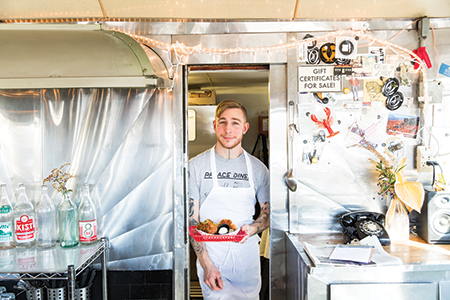
Chad Conley, co-owner and chef of Palace Diner in Biddeford, Maine
Finding the familiar on the menu is crucial to diners, most restaurateurs believe. The Palace Diner in Biddeford, Maine, a 90-year-old, 15-seat diner car, is a local icon. “Just keep it simple. No need to do anything other than the classics as long as you’re doing them well,” says chef and co-owner Chad Conley.
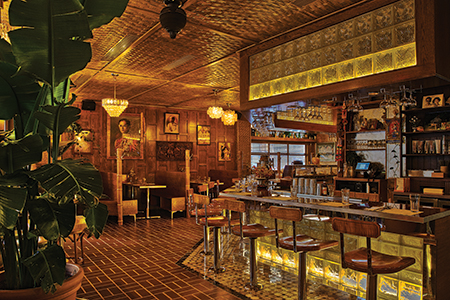
The counter at Thai Diner
While most of these institutions are a throwback when it comes to design, the food is anything but. Local produce and inventive recipes are upping the quality of the dishes served. At Thai Diner, steak and eggs get an update with a spicy dipping sauce and sticky rice; at Rose’s Fine Food in Detroit, a patty melt is elevated with a burger patty made with bone marrow; at Phoenicia Diner, corned beef hash is made with their own house-cured, pasture-raised brisket. “We are, of course, cooking a lot of eggs and making many turkey clubs, but those eggs are from a local farm and the turkey is smoked in our wood-fired smoker,” explains the West Taghkanic Diner’s Schram. “It takes just as much work, craft and creativity to make that sandwich as it does food at fine dining restaurants, but the experience around it isn’t fussy.” And that’s why diners are so beloved. “We feel it’s important that all dishes be recognizable, and that goes for the ingredients, as well,” says Tony Fant, the president of GrandLife Hotels, which includes NYC’s Soho Grand Hotel, home to Soho Diner.
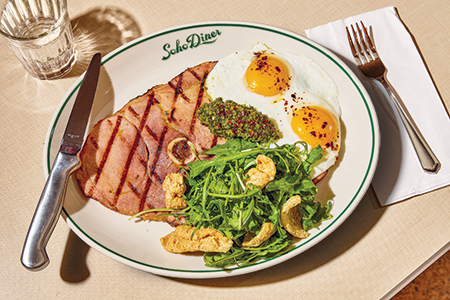
Soho Diner in New York City
New York City alone has seen five upscale diners open in the past six months: José Andrés’ Spanish Diner at Mercado Little Spain in Hudson Yards, Champs vegan diner in Williamsburg, Brooklyn, Golden Diner in Chinatown, Thai Diner in Nolita and Soho Diner in Soho. The 4,900-square-foot Soho Diner features salmon terrazzo floors, a breakfast counter with an open kitchen, custom walnut booth seats and Formica tabletops. Black-and-cream banquettes offer a nod to turn-of-the-century pharmacy booths, as do deco streamline factory lights and globes with mid-century pendants. Diner design that lacks pretense is very important.
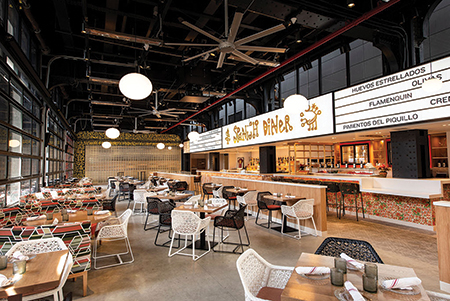
Inside the Spanish Diner
West Taghkanic Diner’s 1953 building hasn’t changed much, and that authentic flavor is baked in. “It has aged really well,” says Schram. “It has this art deco feel with terrazzo floors, curved lines and lots of chrome. We added little modern touches that play well with the original feel.” Rose’s Fine Food, a local haunt since 1964, boasts beautiful details like a stainless steel back counter, swiveling stools and glazed brick. “I knew I wanted to create an inviting space for all walks of life with really good food,” says owner Molly Mitchell.
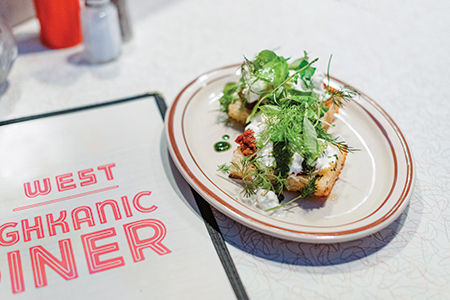
“WTD” pizza at West Taghkanic Diner
Thai Diner’s Redding and Matt Danzer, who also co-own together the Michelin-starred Uncle Boons, were careful to marry Americana with a distinctly Thai aesthetic. Chrome, glass blocks, old-school cake displays, mid-century chandeliers and booths intermingle with Thai materials such as teak and bamboo and retro posters. “When I was a kid, I had a pretend diner called Ann’s Diner, where my parents and sister would come and order whatever they liked,” says Redding. “When I first moved to New York City, I lived half a block from [iconic Ukrainian diner] Veselka, and it was like a second home.”
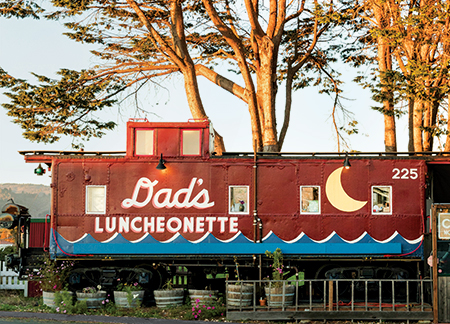
Outside Dad’s Luncheonette in Half Moon Bay
“Diners have always been, and hopefully always will be, the epitome of a democratic, all-inclusive restaurant,” says Fant. “Too many restaurants these days cater to a homogenized crowd of sameness, and it’s rare to see all demographics sharing the same space.” There is a comfort in knowing what you’re going to get—especially in uncertain times. “I love all iterations of diners,” says Mitchell. “I always feel at ease when I spot the stools and the stainless steel.”





